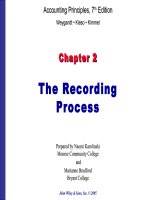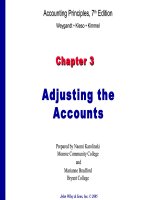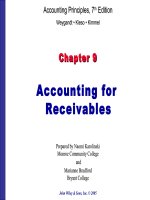Accounting principles 7th kieso kimel chapter 06
Bạn đang xem bản rút gọn của tài liệu. Xem và tải ngay bản đầy đủ của tài liệu tại đây (1.36 MB, 62 trang )
Accounting Principles, 7th Edition
Weygandt • Kieso • Kimmel
Chapter 6
Inventories
Prepared by Naomi Karolinski
Monroe Community College
and
Marianne Bradford
Bryant College
John Wiley & Sons, Inc. © 2005
CHAPTER 6
INVENTORIES
After studying
this chapter, you should be able to:
1
2
3
4
5
6
Describe steps in determining inventory
quantities
Explain the basis of accounting for inventories
and describe the inventory cost flow methods
Explain the financial statements and the tax
effects of each inventory cost flow method
Explain the lower of cost or market basis of
accounting for inventories
Indicate the effects of inventory errors on the
financial statements
Compute and interpret inventory turnover
INVENTORY
BASICS
• Balance sheet of merchandising and
manufacturing companies
– inventory significant current asset
• Income statement
– inventory is vital in determining results
• Gross profit
– (net sales - cost of goods sold)
• watched by management, owners, and others
MERCHANDISE INVENTORY
CHARACTERISTICS
Merchandise inventory
1 Owned by the company
2 In a form ready for sale
CLASSIFYING INVENTORY IN A
MANUFACTURING
ENVIRONMENT
•Manufacturing inventories
– may not yet be ready for sale
•Classified into three categories:
1 Finished goods
ready for sale
2 Work in process
various stages of production
(not completed)
3 Raw materials
components on hand waiting to be used
DETERMINING INVENTORY
QUANTITIES
STUDY OBJECTIVE 1
To prepare financial statements determine
1. the number of units in inventory by
taking a physical inventory of goods on
hand physical inventory by counting,
weighing or measuring
2. The ownership of goods
DETERMINING COST
OF GOODS ON HAND
3. apply unit costs to the total units on
hand for each item
4. total the cost of each item of inventory to
determine total cost of goods on hand
TAKING A PHYSICAL
INVENTORY
Internal control principles for inventory:
1 Segregation of duties
counting by employees not having
custodial responsibility for the inventory
2 Establishment of responsibility
each counter should establish the
authenticity of each inventory item
TAKING A PHYSICAL
INVENTORY
3 Independent internal verification
second count by another employee
4 Documentation procedures
pre-numbered inventory tags
5 Independent internal verification
designated supervisor checks all inventory
items tags, no items have more than one
tag
OWNERSHIP OF GOODS IN
TRANSIT
• Goods in transit:
included in the inventory of the party that has
legal title to the goods
• FOB (Free on Board) shipping point:
ownership of the goods passes to the buyer when
the public carrier accepts the goods from the
seller
• FOB destination point:
legal title to the goods remains with the seller
until the goods reach the buyer
TERMS OF
SALE
CONSIGNED GOODS
Consignment:
the holder of the goods (consignee) does
not own the goods
– ownership remains with the consignor of
the goods until the goods are sold
– consigned goods should be included in the
consignor’s inventory, not the consignee’s
inventory
Owned by a consignor; do not
count in consignee
inventory
Consignee Company
INVENTORY
ACCOUNTING SYSTEMS
1 Perpetual
• detailed records
• cost of each item maintained
• cost of each item sold is determined when
sale occurs
2 Periodic
• cost of goods sold is determined at the end
of accounting period
Basis of Accounting for
Inventories
Periodic Cost Flow Methods
STUDY OBJECTIVE 2
• Revenues from the sale of merchandise are
recorded when sales are made in the same way
as in a perpetual system.
• No calculation of cost of goods sold is made at
the time of sale of the merchandise.
• Physical inventories are taken at end of period
to determine:
– the cost of merchandise on hand
– the cost of the goods sold during the period
ALLOCATING
INVENTORIABLE
COSTS
• Inventory costs- periodic
inventory system
– allocated between ending inventory and cost of goods sold
– allocation is made at the end of the accounting period
1 the costs assignable to the ending inventory are
determined
2 the cost of the ending inventory is subtracted
from the cost of goods available for sale to
determine the cost of goods sold
3 cost of goods sold is then deducted from sales
revenues in accordance with the matching
principle to get gross profit
COST OF GOODS
SOLD
Cost of Goods Sold –Review
Periodic inventory system
Three steps are required:
1. record purchases of merchandise,
2. determine the cost of goods
purchased,
3. determine the cost of goods on hand
at the beginning and end of the
accounting period
DETERMINING COST OF
GOODS PURCHASED
To determine Cost of Goods Purchased:
1 subtract contra purchase accounts of
Purchases Discounts and Purchases
Returns and Allowances from
Purchases to get Net Purchases
2 add Freight-in to Net Purchases
ALLOCATION (MATCHING) OF
POOL OF COSTS
STUDY OBJECTIVE 5
$ 120,000
The cost of goods available for sale is
allocated between
a.
b.
c.
d.
beginning inventory and ending inventory.
beginning inventory and cost of goods on hand.
cost of goods purchased and cost of goods sold.
beginning inventory and cost of goods purchased.
The cost of goods available for sale is
allocated between
a.
b.
c.
d.
beginning inventory and ending inventory.
beginning inventory and cost of goods on hand.
cost of goods purchased and cost of goods sold.
beginning inventory and cost of goods purchased.
USING ACTUAL
PHYSICAL
• CostingFLOW
of the inventory
is complicated because
COSTING
specific items of inventory on hand may have
been purchased at different prices.
• The specific identification method tracks the
actual physical flow of the goods.
• Each item of inventory is marked, tagged, or
coded with its specific unit cost.
• Items still in inventory at the end of the year are
specifically costed to arrive at the total cost of
the ending inventory.
SPECIFIC IDENTIFICATION
METHOD
USING ASSUMED COST FLOW
METHODS
• Other cost flow methods are allowed since
specific identification is often impractical.
• These methods assume flows of costs that may be
unrelated to the physical flow of goods.
• For this reason we call them assumed cost flow
methods or cost flow assumptions. They are:
1 First-in, first-out (FIFO).
2 Last-in, first-out (LIFO).
3 Average cost.
FIFO
• The FIFO method
– earliest goods purchased are the first to be sold.
– often parallels the actual physical flow of
merchandise.
– the costs of the earliest goods purchased are the
first to be recognized as cost of goods sold.
FIFO









